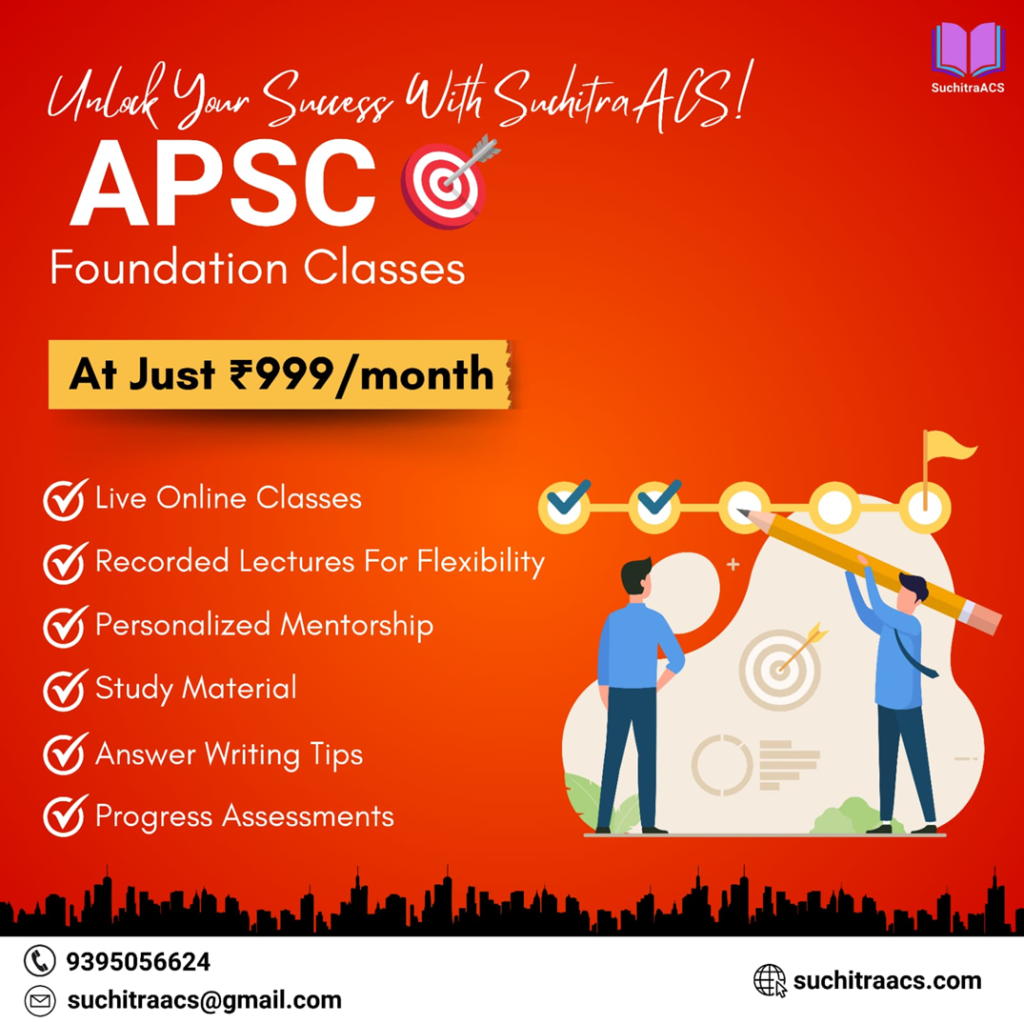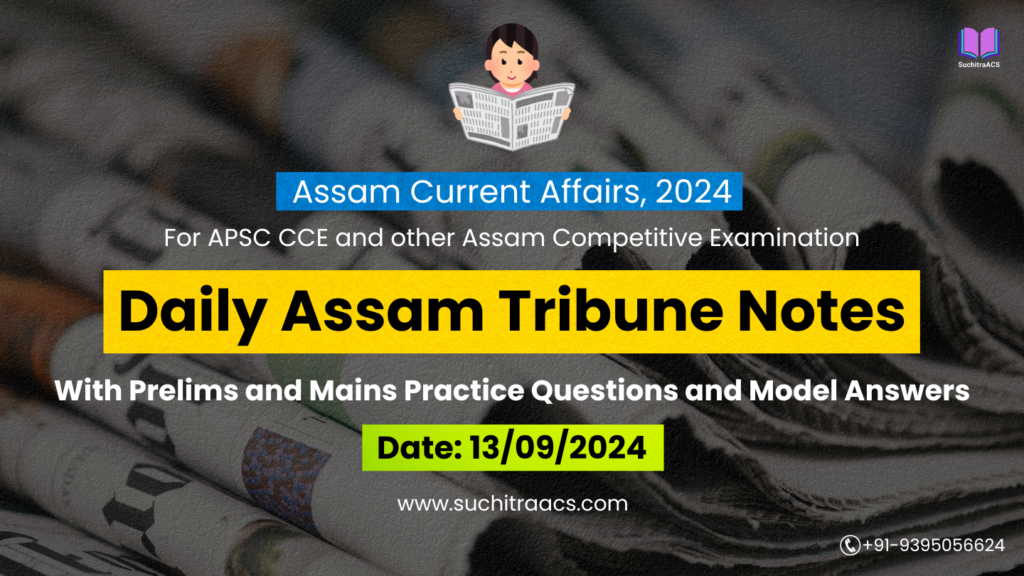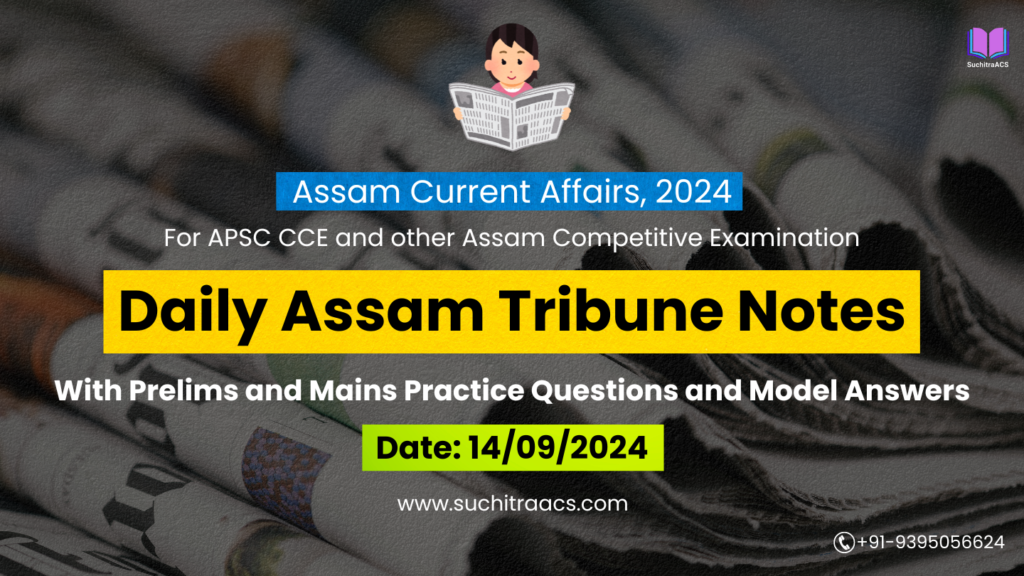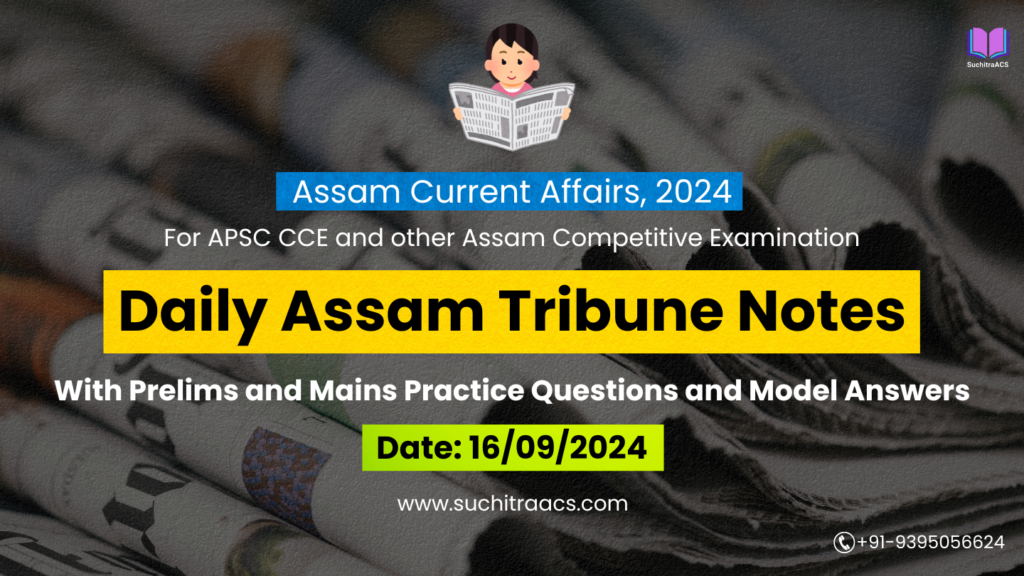1. Assamese as a Classical Language
GS Paper II – Polity, Governance, and Cultural Heritage
Introduction:
Assam Chief Minister Himanta Biswa Sarma has requested Prime Minister Narendra Modi to declare Assamese as one of the classical languages of India. This move would provide government support for the preservation and promotion of the Assamese language, making it a pivotal step for the state’s cultural and linguistic heritage.
Key Points:
- Classical Language Status:
- The status allows for central funding for research, preservation of ancient manuscripts, and the promotion of the language.
- Assamese could join the list of six classical languages: Tamil, Sanskrit, Kannada, Telugu, Malayalam, and Odia.
- Cultural Impact:
- Recognition of Assamese as a classical language would boost regional pride and enhance efforts to conserve Assam’s literary heritage.
- Increased support for scholarly research in universities.
Prelims Focus:
- Criteria for a language to be recognized as classical in India.
- Current classical languages of India.
Mains Focus:
- Cultural Preservation: How the status of classical language can help protect Assamese culture, heritage, and literature.
- Governance and Policy: The role of government initiatives in promoting and preserving regional languages and the challenges in securing classical status.
- Challenges: Documentation and revival of ancient texts, proper implementation of grants, and ensuring local community participation.
Conclusion:
The recognition of Assamese as a classical language would be a significant cultural achievement for the state, enabling future generations to benefit from government-supported research, conservation, and academic initiatives focused on Assamese language and literature.
2. Act East Policy and the Northeast
GS Paper II – International Relations, Economic Development
Introduction:
The Act East Policy aims to enhance India’s ties with Southeast Asian nations. The policy emphasizes the importance of the Northeast as a key player in promoting trade, connectivity, and people-to-people links with ASEAN countries.
Key Points:
- Strategic Importance of Northeast:
- The region serves as a bridge to Southeast Asia, providing access to ASEAN markets.
- Key sectors like agriculture, handicrafts, renewable energy, and tourism hold significant potential for collaboration with Southeast Asian countries.
- Economic Cooperation:
- Focus on infrastructure development, including highways and trade corridors to improve connectivity with ASEAN.
- Promoting sectors like eco-tourism and renewable energy to attract foreign investment.
Prelims Focus:
- The key objectives of the Act East Policy.
- ASEAN’s role in the Indo-Pacific region.
Mains Focus:
- Economic Potential of the Northeast: How enhancing connectivity can boost trade, infrastructure, and development in the region.
- Challenges: Addressing issues like political instability, insurgency, and inadequate infrastructure in the Northeast, which could hinder economic growth.
- Geopolitical Role: The importance of India’s diplomatic engagement and security cooperation to ensure smooth implementation of the policy.
Conclusion:
The Act East Policy presents an opportunity to transform the Northeast into a dynamic hub of trade and investment. However, to realize this vision, it is essential to prioritize infrastructure development, economic cooperation, and cross-border collaboration.
3. Compressed Biogas Plants in Assam
GS Paper III – Environment, Energy, and Sustainable Development
Introduction:
Assam is set to establish 25 Compressed Biogas (CBG) plants by 2025 as part of India’s national drive for sustainable energy. These plants will convert organic waste into renewable biogas, contributing to both waste management and energy production.
Key Points:
- Compressed Biogas (CBG):
- Produced from agricultural residue, cattle dung, and municipal waste.
- A clean, renewable energy source that reduces carbon emissions and dependence on fossil fuels.
- Role of Oil India Limited (OIL):
- OIL is spearheading the establishment of four major CBG plants in Guwahati, Jorhat, Sivasagar, and Tinsukia.
- Government Support:
- The central government is providing financial incentives for the development of CBG projects under its sustainable energy policy.
Prelims Focus:
- The process of Compressed Biogas (CBG) production.
- India’s national initiatives for renewable energy.
Mains Focus:
- Sustainable Energy: How CBG can contribute to reducing carbon emissions and promote green energy.
- Government Initiatives: The role of public-private partnerships in promoting sustainable energy in India.
- Challenges:
- Infrastructure and logistical challenges in waste collection and plant establishment.
- Public awareness and participation in the biogas sector.
Conclusion:
Assam’s focus on CBG production reflects the state’s commitment to renewable energy and environmental conservation. This initiative aligns with India’s larger goal of achieving a cleaner and greener energy future.
4. Orang National Park and Tiger Reserve
GS Paper III – Environment, Biodiversity, and Wildlife Conservation
Introduction:
Orang National Park and Tiger Reserve has officially reopened for the 2024-25 season, following an expansion that increased its total area to 300 sq km. The park is home to some of the most iconic species, including the one-horned rhinoceros and Royal Bengal Tiger.
Key Points:
- Expansion and Conservation:
- The park has been expanded to include a 180 km animal corridor, linking it to Kaziranga National Park and other wildlife sanctuaries.
- Rhino Population: The park hosts 128 one-horned rhinos and 28 Royal Bengal tigers.
- Eco-Tourism:
- The reopening of the park is expected to boost eco-tourism and raise awareness about wildlife conservation.
Prelims Focus:
- Location and significance of Orang National Park.
- Species conservation efforts in the park, particularly for tigers and rhinoceros.
Mains Focus:
- Conservation Efforts: The role of national parks in preserving endangered species and promoting biodiversity.
- Eco-Tourism and Sustainable Development: How eco-tourism can generate revenue while supporting conservation efforts.
- Challenges:
- Ensuring that the expansion of eco-tourism does not negatively affect the fragile ecosystem.
- Balancing wildlife protection with infrastructure development.
Conclusion:
The reopening of Orang National Park and its expansion marks a significant step towards wildlife conservation and eco-tourism in Assam. It underscores the state’s commitment to protecting endangered species and promoting sustainable development.
5. Poshan Abhiyan: A Case Study in Ethics and Social Responsibility
GS Paper IV – Ethics in Governance, Social Justice
Introduction: The Poshan Abhiyan 2024 has been successfully implemented across Assam and India. The focus of the mission is on improving the nutritional status of children under six, pregnant women, and lactating mothers. Ethical governance, social responsibility, and public welfare are central to the success of the program. Assam’s tea gardens, known for high child and maternal mortality rates, are one of the primary focus areas.
Key Points:
- Social Responsibility and Government’s Role:
- The government has a moral responsibility to uplift marginalized sections of society, especially vulnerable groups like children and pregnant women.
- The 7th edition of Poshan Abhiyan has specifically targeted regions with poor nutritional indicators, like Assam’s tea gardens.
- Ethical governance demands equitable resource distribution and the delivery of essential services to vulnerable populations.
- Role of Ethical Leadership:
- Leaders like Ajanta Neog, Assam’s Finance Minister, emphasize the ethical obligation of the government to protect and provide for vulnerable groups, advocating for improved healthcare infrastructure and resources.
- Ethical leadership in public health programs ensures that administrative actions are aligned with human rights, dignity, and justice.
Prelims Focus:
- Poshan Abhiyan and its objectives.
- Ethical responsibilities in public health policy.
Mains Focus:
- Ethics in Governance: How ethical leadership plays a pivotal role in the implementation of public health programs like Poshan Abhiyan.
- Social Justice: Addressing malnutrition, maternal mortality, and child welfare are ethical imperatives for any welfare state.
- Challenges:
- Ensuring equitable access to nutrition and healthcare services in remote areas.
- Overcoming logistical issues in reaching vulnerable populations such as tea garden workers and underprivileged rural communities.
- Monitoring transparency in the delivery of services and ensuring accountability.
Conclusion: The Poshan Abhiyan 2024 in Assam highlights the intersection of ethics and public policy. By addressing the nutritional needs of vulnerable populations, the program demonstrates a model of governance where social justice and ethical responsibility are prioritized. To sustain such initiatives, continued ethical leadership, effective resource management, and an unwavering commitment to social welfare are essential.
APSC Prelims Practice Questions
1. Which of the following is NOT a direct benefit of declaring a language as a classical language in India?
(a) Central government funding for research and preservation
(b) Establishment of specialized linguistic departments in universities
(c) Mandatory inclusion in school curriculums across India
(d) Promotion of ancient literature and manuscripts
Answer: (c) Mandatory inclusion in school curriculums across India
Explanation:
While classical language status provides government funding for research, conservation, and promotion, it does not mandate inclusion in school curriculums across India. The status focuses on preservation and scholarly promotion, such as through universities and research bodies.
2. Which of the following is a key criterion for recognizing a language as a classical language in India?
(a) The language must be spoken by a large portion of the population.
(b) The language must have a literary tradition dating back over 1,500 years.
(c) The language should be the official language of at least three states.
(d) The language must be used in trade and commerce for at least 500 years.
Answer: (b) The language must have a literary tradition dating back over 1,500 years.
Explanation:
To qualify as a classical language, the language must have a literary tradition of at least 1,500 years, as well as a rich body of ancient literature. It need not be widely spoken or used for official purposes in multiple states.
3. Which of the following statements about Compressed Biogas (CBG) is correct?
(a) CBG is produced only from fossil fuels.
(b) CBG helps reduce carbon emissions and provides renewable energy.
(c) CBG plants are intended solely for urban areas with industrial waste.
(d) CBG does not contribute to waste management efforts.
Answer: (b) CBG helps reduce carbon emissions and provides renewable energy.
Explanation:
Compressed Biogas (CBG) is produced from organic waste materials such as agricultural residue, cattle dung, and municipal waste. It helps reduce carbon emissions and offers a clean and renewable energy source, contributing to both energy production and waste management.
4. What is the primary objective of the expansion of Orang National Park and Tiger Reserve in Assam?
(a) To develop the park for industrial and commercial use
(b) To create a wildlife corridor linking Orang National Park with Kaziranga
(c) To expand the tourist infrastructure within the park
(d) To relocate the park’s resident species to other states
Answer: (b) To create a wildlife corridor linking Orang National Park with Kaziranga
Explanation:
The primary objective of the expansion of Orang National Park is to create a 180 km wildlife corridor that links Orang with Kaziranga National Park and other nearby sanctuaries, ensuring safe passage for wildlife and promoting biodiversity conservation.
5. Which of the following is NOT a challenge for implementing compressed biogas (CBG) plants on a large scale in Assam?
(a) Infrastructure development for waste collection
(b) Lack of public awareness and participation
(c) Limited availability of organic waste
(d) Technological challenges in large-scale biogas conversion
Answer: (c) Limited availability of organic waste
Explanation:
In Assam, the availability of organic waste (such as agricultural residue and cattle dung) is not a limiting factor. However, challenges include the infrastructure for waste collection, public awareness, and the technological development required for large-scale biogas conversion.
6. Under the Poshan Abhiyan 2024, which group is specifically targeted for improved nutrition in Assam’s tea gardens?
(a) Adult males
(b) Elderly citizens
(c) Pregnant women, lactating mothers, and children under six
(d) Government employees in rural Assam
Answer: (c) Pregnant women, lactating mothers, and children under six
Explanation:
The Poshan Abhiyan specifically targets improving the nutritional status of pregnant women, lactating mothers, and children under six, particularly in Assam’s tea gardens, which have been noted for high maternal and child mortality rates.
APSC Mains Practice Question
Question:
“Discuss the significance of establishing compressed biogas (CBG) plants in Assam. What are the challenges involved in the implementation of such projects, and how can these be addressed?”
(Answer in 250 words)
Model Answer:
Introduction:
The establishment of Compressed Biogas (CBG) plants in Assam is a significant step towards promoting sustainable energy and reducing the state’s dependence on fossil fuels. As part of India’s national agenda, Assam aims to set up 25 CBG plants by 2025, with key projects in cities like Guwahati, Jorhat, Sivasagar, and Tinsukia.
Significance of CBG Plants:
- Environmental Benefits: CBG is a clean and renewable energy source that helps reduce carbon emissions and mitigates environmental pollution by utilizing organic waste.
- Waste Management: CBG production from agricultural residue, cattle dung, and municipal waste not only generates energy but also contributes to waste management, turning waste into a valuable resource.
- Energy Security: By tapping into renewable sources, Assam can reduce its reliance on fossil fuels and enhance energy security.
- Economic Benefits: CBG plants provide opportunities for rural development, as they create jobs in waste collection and energy production.
Challenges:
- Infrastructure Development: The establishment of large-scale biogas plants requires significant investment in infrastructure, including waste collection and transportation systems.
- Public Awareness: Limited awareness among the public, especially farmers, about the benefits of CBG and how to participate in the waste supply chain.
- Technological Constraints: The need for advanced biogas conversion technology to ensure efficient and large-scale production remains a challenge.
Suggestions to Overcome Challenges:
- Government Support: Increased financial incentives and subsidies for biogas production can encourage private sector participation.
- Public Awareness Campaigns: Raising awareness about the economic and environmental benefits of CBG will help garner public support.
- Technological Upgradation: Investment in research and development of efficient biogas technologies will be crucial for the successful implementation of CBG plants.
Conclusion:
The establishment of CBG plants in Assam holds immense potential for addressing energy needs while promoting environmental sustainability. Overcoming challenges related to infrastructure, technology, and public participation will be key to maximizing the benefits of this initiative.
✨ Looking for top-quality APSC online coaching at an affordable price?

🔔 Join Our WhatsApp Study Group!
For exclusive access to premium quality content, including study materials, current affairs, MCQs, and model answers for APSC CCE and other Assam competitive exams.
Click here to join: SuchitraACS Study WhatsApp Group
📚 Want to know more about SuchitraACS’s most affordable courses?
Click here to know more: SuchitraACS Courses for APSC CCE and Assam Competitive Examinations




